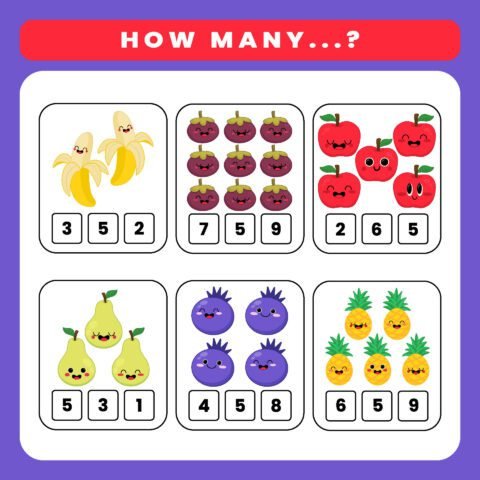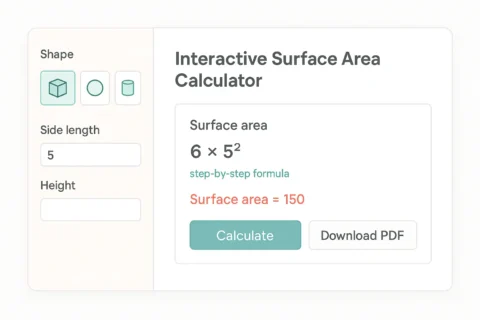What is Exponential Notation?
Exponential notation is a mathematical shorthand for expressing repeated multiplication of the same number. Instead of writing \( 5 \times 5 \times 5 \times 5 \), we use exponential notation to write \( 5^4 \). This notation consists of a base (the number being multiplied) and an exponent (how many times it's multiplied by itself). Standard exponential notation is essential in mathematics, science, and engineering for representing very large or very small numbers efficiently.
Key Components of Exponential Notation:
Base
The number being multiplied
5
Exponent
Number of times multiplied
4
Power
The complete expression
\( 5^4 \)
Exponential Notation with Positive Exponents
📐 Definition: \( a^n = \underbrace{a \times a \times \ldots \times a}_{n \text{ times}} \)
When the exponent is positive, it tells us how many times to multiply the base by itself.
\( 3^1 = 3 \) (the base appears once)
\( 3^2 = 3 \times 3 = 9 \) (the base appears twice)
\( 3^3 = 3 \times 3 \times 3 = 27 \) (the base appears three times)
\( 3^4 = 3 \times 3 \times 3 \times 3 = 81 \) (the base appears four times)
Common Examples
\( 2^5 = 2 \times 2 \times 2 \times 2 \times 2 = 32 \)
Read as: "Two to the fifth power" or "Two to the power of five"
\( 10^3 = 10 \times 10 \times 10 = 1,000 \)
Read as: "Ten cubed" or "Ten to the third power"
\( 7^2 = 7 \times 7 = 49 \)
Read as: "Seven squared" or "Seven to the second power"
How to Type Exponential Notation with Positive Exponents
Method 1: Using Superscript (Computer/Word Processing)
- Type the base number: 5
- Select the exponent formatting (Ctrl+Shift++ in Word, or Format > Font > Superscript)
- Type the exponent: 3
- Result: 5³
Method 2: Using Caret Symbol (Programming/Calculators)
- Type: 5^3
- This represents 5 to the power of 3
- Common in Excel, calculators, and programming languages
Method 3: Unicode Superscript Characters
Copy these superscript numbers:
⁰ ¹ ² ³ ⁴ ⁵ ⁶ ⁷ ⁸ ⁹
Example: 5³ (paste the ³ after the base)
Multiplication of Numbers in Exponential Form
📊 The Product Rule for Exponents
When multiplying powers with the same base: \( a^m \times a^n = a^{m+n} \)
Rule: Keep the base, add the exponents
Example 1: Same Base Multiplication
\( 3^4 \times 3^2 = 3^{4+2} = 3^6 = 729 \)
Verification:
\( 3^4 = 81 \) and \( 3^2 = 9 \), so \( 81 \times 9 = 729 \) ✓
Example 2: Powers of 10
\( 10^5 \times 10^3 = 10^{5+3} = 10^8 = 100,000,000 \)
Verification:
\( 10^5 = 100,000 \) and \( 10^3 = 1,000 \), so \( 100,000 \times 1,000 = 100,000,000 \) ✓
Example 3: Different Bases (Cannot Use Product Rule)
\( 2^3 \times 5^2 \) ≠ \( 10^5 \) or any simple form
Must calculate separately:
\( 2^3 = 8 \) and \( 5^2 = 25 \), so \( 8 \times 25 = 200 \)
Standard Exponential Notation
What Makes It "Standard"?
Standard exponential notation follows specific conventions:
- Base is written normally: As a regular number (5, not ₅)
- Exponent is superscript: Written as a raised number (\( 5^3 \), not 5³ in text)
- Positive exponents: Typically shown without a + sign (\( 5^3 \), not \( 5^{+3} \))
- Proper formatting: No spaces between base and exponent
\( 6 \times 6 \times 6 \times 6 = 6^4 \)
\( 10 \times 10 \times 10 \times 10 \times 10 = 10^5 \)
\( 2 \times 2 \times 2 \times 2 \times 2 \times 2 = 2^6 \)
Frequently Asked Questions
What is exponential notation?
Exponential notation is a mathematical shorthand for representing repeated multiplication. It consists of a base (the number being multiplied) raised to an exponent (the number of times it's multiplied by itself). For example, \( 5^3 \) means \( 5 \times 5 \times 5 = 125 \).
How do you write exponential notation with positive exponents?
To write exponential notation with positive exponents: (1) Identify the base (the number being multiplied), (2) Count how many times it appears in the multiplication, (3) Write as base^exponent. Example: \( 7 \times 7 \times 7 \times 7 = 7^4 \). The positive exponent 4 means multiply 7 by itself 4 times.
What is the rule for multiplication of numbers in exponential form?
For multiplication of numbers in exponential form with the same base, use the product rule: \( a^m \times a^n = a^{m+n} \). Keep the base the same and add the exponents. Example: \( 3^4 \times 3^2 = 3^{4+2} = 3^6 \). If bases are different, you must calculate each power separately then multiply.
What is standard exponential notation?
Standard exponential notation is the conventional way of writing exponential expressions: base written as a normal number with the exponent as a superscript. It follows rules like \( a^n \) where \( a \) is the base and \( n \) is the exponent. Positive exponents don't require a + sign: write \( 5^3 \), not \( 5^{+3} \).
How do you type exponential notation with positive exponents on a computer?
To type exponential notation with positive exponents: (1) In Word: use Ctrl+Shift++ for superscript, (2) In calculators/Excel: use the caret symbol (5^3), (3) Copy Unicode superscripts: ⁰¹²³⁴⁵⁶⁷⁸⁹, (4) In LaTeX: use base^{exponent} format.
What's the difference between \( 2^3 \) and \( 2 \times 3 \)?
\( 2^3 \) in exponential notation means \( 2 \times 2 \times 2 = 8 \) (2 multiplied by itself 3 times). \( 2 \times 3 \) is simple multiplication equaling 6. The exponent tells you how many times to multiply the base by itself, not what to multiply it by.
How do you read exponential notation?
Exponential notation is read as "base to the power of exponent" or using special terms: \( a^2 \) is "a squared," \( a^3 \) is "a cubed," \( a^4 \) is "a to the fourth power." Example: \( 5^6 \) reads as "five to the sixth power" or "five to the power of six."
Can you multiply different bases in exponential form?
When multiplying numbers in exponential form with different bases, you cannot use the product rule. You must calculate each power separately, then multiply. Example: \( 2^3 \times 5^2 = 8 \times 25 = 200 \). The product rule \( a^m \times a^n = a^{m+n} \) only works when bases are identical.
What does a positive exponent mean?
A positive exponent indicates standard repeated multiplication. \( a^n \) where \( n \) is positive means multiply \( a \) by itself \( n \) times. The larger the positive exponent, the larger the result (when base > 1). Example: \( 3^1 = 3 \), \( 3^2 = 9 \), \( 3^3 = 27 \), \( 3^4 = 81 \).
Why is exponential notation important?
Exponential notation is crucial because it: (1) Simplifies writing repeated multiplication, (2) Handles very large and small numbers efficiently, (3) Is essential for scientific notation, (4) Forms the basis for logarithms and exponential functions, (5) Appears throughout algebra, calculus, and science. It's a fundamental mathematical tool.


